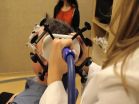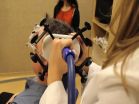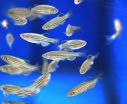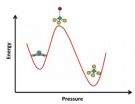(Press-News.org) VIDEO:
Stimulating a region in the brain with non-invasive electrical current using magnetic pulses (Transcranial Magnetic Stimulation) improves memory, reports a new Northwestern Medicine study in Science. The discovery opens...
Click here for more information.
CHICAGO --- Stimulating a particular region in the brain via non-invasive delivery of electrical current using magnetic pulses, called Transcranial Magnetic Stimulation, improves memory, reports a new Northwestern Medicine® study.
The discovery opens a new field of possibilities for treating memory impairments caused by conditions such as stroke, early-stage Alzheimer's disease, traumatic brain injury, cardiac arrest and the memory problems that occur in healthy aging.
"We show for the first time that you can specifically change memory functions of the brain in adults without surgery or drugs, which have not proven effective," said senior author Joel Voss, assistant professor of medical social sciences at Northwestern University Feinberg School of Medicine. "This noninvasive stimulation improves the ability to learn new things. It has tremendous potential for treating memory disorders."
The study will be published August 29 in Science.
The study also is the first to demonstrate that remembering events requires a collection of many brain regions to work in concert with a key memory structure called the hippocampus – similar to a symphony orchestra. The electrical stimulation is like giving the brain regions a more talented conductor so they play in closer synchrony.
"It's like we replaced their normal conductor with Muti," Voss said, referring to Riccardo Muti, the music director of the renowned Chicago Symphony Orchestra. "The brain regions played together better after the stimulation."
The approach also has potential for treating mental disorders such as schizophrenia in which these brain regions and the hippocampus are out of sync with each other, affecting memory and cognition.
TMS Boosts Memory
The Northwestern study is the first to show TMS improves memory long after treatment. In the past, TMS has been used in a limited way to temporarily change brain function to improve performance during a test, for example, making someone push a button slightly faster while the brain is being stimulated. The study shows that TMS can be used to improve memory for events at least 24 hours after the stimulation is given.
Finding the Sweet Spot
It isn't possible to directly stimulate the hippocampus with TMS because it's too deep in the brain for the magnetic fields to penetrate. So, using an MRI scan, Voss and colleagues identified a superficial brain region a mere centimeter from the surface of the skull with high connectivity to the hippocampus. He wanted to see if directing the stimulation to this spot would in turn stimulate the hippocampus. It did.
"I was astonished to see that it worked so specifically," Voss said.
When TMS was used to stimulate this spot, regions in the brain involved with the hippocampus became more synchronized with each other, as indicated by data taken while subjects were inside an MRI machine, which records the blood flow in the brain as an indirect measure of neuronal activity.
The more those regions worked together due to the stimulation, the better people were able to learn new information.
How the Study Worked
Scientists recruited 16 healthy adults ages 21 to 40. Each had a detailed anatomical image taken of his or her brain as well as 10 minutes of recording brain activity while lying quietly inside an MRI scanner. Doing this allowed the researchers to identify each person's network of brain structures that are involved in memory and well connected to the hippocampus. The structures are slightly different in each person and may vary in location by as much as a few centimeters.
"To properly target the stimulation, we had to identify the structures in each person's brain space because everyone's brain is different," Voss said.
Each participant then underwent a memory test, consisting of a set of arbitrary associations between faces and words that they were asked to learn and remember. After establishing their baseline ability to perform on this memory task, participants received brain stimulation 20 minutes a day for five consecutive days.
During the week they also received additional MRI scans and tests of their ability to remember new sets of arbitrary word and face parings to see how their memory changed as a result of the stimulation. Then, at least 24 hours after the final stimulation, they were tested again.
At least one week later, the same experiment was repeated but with a fake placebo stimulation. The order of real stimulation and placebo portions of the study was reversed for half of the participants, and they weren't told which was which.
Both groups performed better on memory tests as a result of the brain stimulation. It took three days of stimulation before they improved.
"They remembered more face-word pairings after the stimulation than before, which means their learning ability improved," Voss said. "That didn't happen for the placebo condition or in another control experiment with additional subjects."
In addition, the MRI showed the stimulation caused the brain regions to become more synchronized with each other and the hippocampus. The greater the improvement in the synchronicity or connectivity between specific parts of the network, the better the performance on the memory test. "The more certain brain regions worked together because of the stimulation, the more people were able to learn face-word pairings, " Voss said.
Using TMS to stimulate memory has multiple advantages, noted first author Jane Wang, a postdoctoral fellow in Voss's lab at Feinberg. "No medication could be as specific as TMS for these memory networks," Wang said. "There are a lot of different targets and it's not easy to come up with any one receptor that's involved in memory."
The Future
"This opens up a whole new area for treatment studies where we will try to see if we can improve function in people who really need it," Voss said.
His current study was with people who had normal memory, in whom he wouldn't expect to see a big improvement because their brains are already working effectively.
"But for a person with brain damage or a memory disorder, those networks are disrupted so even a small change could translate into gains in their function," Voss said.
In an upcoming trial, Voss will study the electrical stimulation's effect on people with early-stage memory loss.
Voss cautioned that years of research are needed to determine whether this approach is safe or effective for patients with Alzheimer's disease or similar disorders of memory.
INFORMATION:
Other Northwestern authors on the paper include Lynn M. Rogers, Evan Z. Gross, Anthony J. Ryals, Mehmet E. Dokucu, Kelly L. Brandstatt and Molly S. Hermiller.
Video Available:
Highlights
First time memory functions of adult brain changed, and without surgery or drugs
First study to show electrical stimulation improves new learning long after treatment
Discovery has potential to treat memory disorders in stroke, Alzheimer's, concussion
Study proves hippocampus plays in concert with other brain regions like a symphony
The research was supported by grants P50-MH094263 from the National Institute of Mental Health and F32-NS083340 from the National Institute of Neurological Disorders and Stroke of the National Institutes of Health.
NORTHWESTERN NEWS: http://www.northwestern.edu/newscenter/
Electric current to brain boosts memory
Discovery may help treat memory disorders resulting from stroke, Alzheimer's and brain injury
2014-08-28
ELSE PRESS RELEASES FROM THIS DATE:
Less than $200 million would conserve precious Atlantic Forest in Brazil, say researchers
2014-08-28
Brazil could conserve its valuable Atlantic Forest by investing just 0.01 per cent of its annual GDP, according to a new study.
The Atlantic Forest (Mata Atlântica) is one of the most important and threatened biodiversity hotspots in the world, containing the only living examples of nearly 10,000 species of plant and more bird species than all of Europe.
Situated along the Atlantic coast of Brazil, it once covered an area of nearly 1.5 million square kilometres. Today, the forest is home to more than 130 million people and it covers only 160,000 km2, because of deforestation. ...
Home is where the microbes are
2014-08-28
A person's home is their castle, and they populate it with their own subjects: millions and millions of bacteria.
A study published today in Science provides a detailed analysis of the microbes that live in houses and apartments. The study was conducted by researchers from the U.S. Department of Energy's Argonne National Laboratory and the University of Chicago.
The results shed light on the complicated interaction between humans and the microbes that live on and around us. Mounting evidence suggests that these microscopic, teeming communities play a role in human ...
New DNA study unravels the settlement history of the New World Arctic
2014-08-28
We know people have lived in the New World Arctic for about 5,000 years. Archaeological evidence clearly shows that a variety of cultures survived the harsh climate in Alaska, Canada and Greenland for thousands of years. Despite this, there are several unanswered questions about these people: Where did they come from? Did they come in several waves? When did they arrive? Who are their descendants? And who can call themselves the indigenous peoples of the Arctic? We can now answer some of these questions, thanks to a comprehensive DNA study of current and former inhabitants ...
Penn-NIH team discover new type of cell movement
2014-08-28
VIDEO:
Penn and NIH researchers have demonstrated a never-before characterized type of cell movement. In this video, a cell's vimentin cytoskeleton (green) pulls the nucleus (red) forward to generate a high-pressure...
Click here for more information.
For decades, researchers have used petri dishes to study cell movement. These classic tissue culture tools, however, only permit two-dimensional movement, very different from the three-dimensional movements that cells make in a ...
How the zebrafish gets its stripes
2014-08-28
This news release is available in German. The zebrafish, a small fresh water fish, owes its name to a striking pattern of blue stripes alternating with golden stripes. Three major pigment cell types, black cells, reflective silvery cells, and yellow cells emerge during growth in the skin of the tiny juvenile fish and arrange as a multilayered mosaic to compose the characteristic colour pattern.
While it was known that all three cell types have to interact to form proper stripes, the embryonic origin of the pigment cells that develop the stripes of the adult fish has ...
Watching the structure of glass under pressure
2014-08-28
Glass has many applications that call for different properties, such as resistance to thermal shock or to chemically harsh environments. Glassmakers commonly use additives such as boron oxide to tweak these properties by changing the atomic structure of glass. Now researchers at the University of California, Davis, have for the first time captured atoms in borosilicate glass flipping from one structure to another as it is placed under high pressure.
The findings may have implications for understanding how glasses and similar "amorphous" materials respond at the atomic ...
Bradley Hospital collaborative study identifies genetic change in autism-related gene
2014-08-28
PROVIDENCE, R.I. – A new study from Bradley Hospital has identified a genetic change in a recently identified autism-associated gene, which may provide further insight into the causes of autism. The study, now published online in the Journal of Medical Genetics, presents findings that likely represent a definitive clinical marker for some patients' developmental disabilities.
Using whole-exome sequencing – a method that examines the parts of genes that regulate protein, called exons - the team identified a genetic change in a newly recognized autism-associated gene, Activity-Dependent ...
Yale study identifies possible bacterial drivers of IBD
2014-08-28
Yale University researchers have identified a handful of bacterial culprits that may drive inflammatory bowel diseases (IBD) such as Crohn's disease and ulcerative colitis, using patients' own intestinal immune responses as a guide.
The findings are published Aug. 28 in the journal Cell.
Trillions of bacteria exist within the human intestinal microbiota, which plays a critical role in the development and progression of IBD. Yet it's thought that only a small number of bacterial species affect a person's susceptibility to IBD and its potential severity.
"A handful ...
Drug shows promise against Sudan strain of Ebola in mice
2014-08-28
August 28, 2014 — (BRONX, NY) — Researchers from Albert Einstein College of Medicine of Yeshiva University and other institutions have developed a potential antibody therapy for Sudan ebolavirus (SUDV), one of the two most lethal strains of Ebola. A different strain, the Zaire ebolavirus (EBOV), is now devastating West Africa. First identified in 1976, SUDV has caused numerous Ebola outbreaks (most recently in 2012) that have killed more than 400 people in total. The findings were reported in ACS Chemical Biology.
Between 30 and 90 percent of people infected with Ebola ...
NASA sees a weaker Tropical Storm Marie
2014-08-28
When NOAA's GOES-West satellite captured an image of what is now Tropical Storm Marie, weakened from hurricane status on August 28, the strongest thunderstorms were located in the southern quadrant of the storm.
NOAA's GOES-West satellite captured an image of Marie on August 28 at 11 a.m. EDT. Bands of thunderstorms circled the storm especially to the north. The National Hurricane Center noted that Marie has continued to produce a small area of convection (rising air that forms the thunderstorms that make up Marie) south and east of the center during some hours on the ...
LAST 30 PRESS RELEASES:
Study finds potential new treatment path for lasting Lyme disease symptoms
Metabolic health before vaccination determines effectiveness of anti-flu response
Department of Energy announces $16 million for traineeships in accelerator science & engineering
MRE 2024 Publication of Enduring Significance Awards
UCalgary researchers quantify the connection between homelessness and mental health disorders
Fourteen years after the Gulf of Mexico oil spill, endemic fishes face an uncertain future
For more open and equitable public discussions on social media, try “meronymity”
Marine microbial populations: Potential sensors of the global change in the ocean
Metacognitive abilities like reading the emotions and attitudes of others may be more influenced by environment than genetics
Salk Professor Satchin Panda named 2023 AAAS fellow
New urine test has higher diagnostic accuracy for prostate cancer
Floating solar’s potential to support sustainable development by addressing climate, water, and energy goals holistically
Drawing a line back to the origin of life
Data-driven music: Converting climate measurements into music
Palaeontology: Discovery of new ancient giant snake in India
Racial discrimination and metabolic syndrome in young Black adults
Adherence to American Cancer Society nutrition and physical activity guidelines among cancer survivors
New urine-based test detects high-grade prostate cancer, helping men avoid unnecessary biopsies
Researchers reduce bias in pathology AI algorithms using foundation models
Properties of new materials for microchips can now be measured well
Maltreated children are three times more likely to develop substance use disorders in adulthood
Two U professors selected as AAAS fellows
Dana-Farber Chief Scientific Officer, Kevin Haigis, PhD, elected as Fellow of the American Association for the Advancement of Science
Siblings with unique genetic change help scientists progress drug search for type 1 diabetes
Four MD Anderson researchers elected AAAS Fellows
Computational biology pioneer Katie Pollard elected as AAAS fellow
New “window-of-opportunity” clinical trials explore cutting-edge treatments for cancers of the liver, head and neck
Can bismuth prevent oil leaks – (and save Norwegians billions)?
Atmospheric isotopes reveal 4.5 billion years of volcanism on Jupiter’s moon Io
An ink for 3D-printing flexible devices without mechanical joints
[Press-News.org] Electric current to brain boosts memoryDiscovery may help treat memory disorders resulting from stroke, Alzheimer's and brain injury







